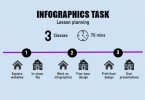Let’s round up day 1 with all of the other things that can be included in the day 1 discussion.
In part 1 of this series we looked at sending home an email to parents and students, either before school starts or very quickly afterwards. The advantage of sending the email in advance of school is that on the very first day with students there is already a structure and familiarity with certain components among certain students that gives you the opportunity to use the very first day productively. Day 1 now gives you an opportunity to get all of the other students on the exact same page.
We also discussed on the first half day that if you also send home your syllabus or other document using Google Forms you can also gather information about the students and the parents before they even arrive on the first day. This is another great means of communicating to students policies procedures and expectations.
Sharing “How-to”
Let’s touch on the other things that are included in my introductory email, the Google form, and the introductory video are links to “how-to” tutorials to access or navigate the various other digital tools that I use throughout the course of the year on a regular basis. For me, that is DeltaMath and Edpuzzle as well as the primary Google Slides that are the framework for the class. These are elements that are included somewhere in the pre-class material, and links to those tutorials are also included in the paper materials so students and parents going to reference back to them as needed throughout the course the class. This becomes important because with potentially multiple children, starting multiple classes, all on the same day, many of the details of a child’s daily life may slip through the cracks. However by providing these resources, as students or parents need to reference what work has been done or hasn’t been done, how to check grades, how to determine what’s next, or if they have an anticipated absence coming and are looking for what’s coming up they need to know where to find that information.
(click HERE or click the picture above to watch a quick “how-to” of navigating my classroom resources)
Getting Help
The other thing that I make sure is included are all of the times that I have set during the day to help students. I also send a message that clearly indicates that if they contact me I can make other times available. This is something that not every teacher can do based on their job responsibilities, or are comfortable with based on their experience. For me, I will go so far as to allow a student to to come to my classroom anytime during the day, even during other classes provided they are not a disruption, because I want to ensure that students have an opportunity to get help when they need help. There is also of course a self-serving purpose; I am eliminating an excuse for not going the extra mile to complete a task or learning objective based on my availability. While I have my own personal beliefs about students who are over scheduled both academically, in extracurriculars, and socially, these are not my problems to solve. My job is to do my very best for that student in my classroom, and now that my classroom extends well beyond my 43 minutes and my four walls it is important that parents and students know how to contact me in order for us to communicate on how best we can help their child achieve their learning objectives.
Supply List
The final thing is something that as a younger teacher I just left to the school supply list or the handbook and assumed parents and students would take care of: the supply list. As a secondary math classroom, I don’t require a great deal of materials; something to write with, something to write on, the learning materials provided by the district, and for me a key component is a set of headphones and a calculator that is appropriate to their course. I am amazed at both the variety and cost of headphones available. I clarify in the video, in the expectation list, and on the first half day of class that the cheapest pair of headphones they can find are sufficient for our needs. I do request that if they have an extra dollar or two that a set of earbuds with inline microphone would be slightly more useful as we will be doing student-created work and the inline microphone might be something they wish to have, and at $4 for headphone with mic that those are very reasonable. The other thing that astounds most of my students, particularly my upper level students, is the fact that I wish them to have a $1 four function calculator. This is another battle that I have spent many years fighting, and determined is not a battle that needs fighting. If a student is not great at arithmetic or multiplication facts it is highly unlikely that multiplication facts is what I am assessing, and so the availability of a four function calculator for tests and learning use is a small concession that is very much worth it. I do take time on the first half day to explain to my advanced math students why they will likely wish to have a four function calculator. If I am assessing their ability to do trigonometric ratios of sine cosine and tangent along with other skills, they can’t have a calculator that short-circuits or undermines their setup or process, but they might need the calculator to overcome arithmetic mistakes.
Get Started Early
By providing students and parents information and resources prior to the start of school using the school email system, or mail as the case may be, you can provide them a head start and an opportunity to reduce frustration or anxiety, while providing yourself a great jumping-off point regardless of how much time you have on day one. As mentioned before the other big advantage is modeling from the start that your job as a teacher is to provide resources and opportunities. While at the same time your expectation is that students will manage their time and manage their resources to accomplish the learning goals that are set out for the class.





